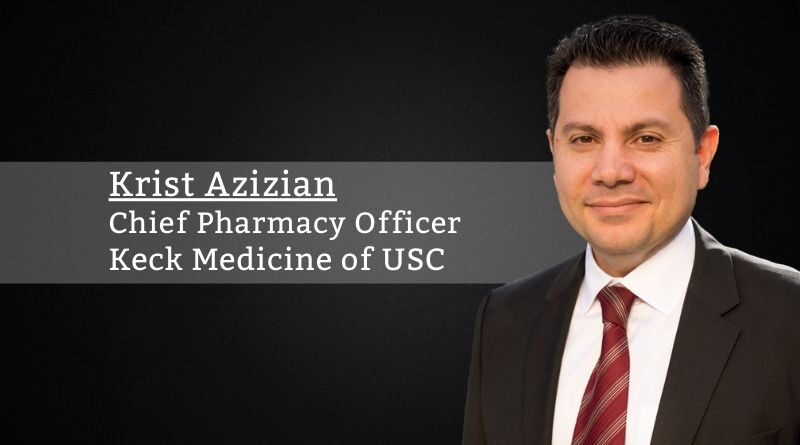Getting Back to Normal for Pharmacists is Not on Our Bingo Card – and That’s a Good Thing
By Krist Azizian, Pharm.D., MHA, Chief Pharmacy Officer | Chief Regional Oncology Officer, Keck Medicine of USC
When lists of healthcare professions are generated, pharmacists are never at the top and sometimes don’t make the list at all. While pharmacists don’t enter the profession for the accolades, many will say their invisibility can be frustrating at times. The primary source of frustration is not the recognition, but the missed opportunities to contribute their talents, experience, and training in ways that advance patient care and solve vexing problems, like supply chain, regulatory challenges, and comprehensive medication management across all settings.
Enter COVID-19. There is a saying that in every crisis lies an opportunity. For pharmacists, the COVID-19 crisis created opportunities to leverage their experience and training to be at the forefront of disease prevention and control, patient care, and drug supply and storage.
What Has Changed, What Will Stick
Patient-facing roles are not new for hospital pharmacists. Pharmacists have been delivering care and managing disease states under protocols and collaborative practice agreements for years. But the demand for clinical pharmacy participation in care teams increased drastically during the pandemic. Pharmacists are spending more time in the emergency department or surge hospitals with physicians, nurses, and the respiratory team and participating in cardiac arrest response for COVID-19 patients and other critical care needs. While this is not different from a clinical pharmacist’s role prior to the pandemic, it has brought to light what these professionals have been doing routinely behind the scenes.
Patient-facing roles are not new for hospital pharmacists. Pharmacists have been delivering care and managing disease states under protocols and collaborative practice agreements for years.
A major contributing factor to the elevated presence of pharmacists in patient-facing roles has been medication management. COVID-19 medication management has been a battle of managing the known versus the unknown of a highly complex virus. St. Joseph Mercy Health System in Ann Arbor, MI, documented that COVID‐19 patients received an average of 19.8 different medications and pharmacists made an average of eight interventions per patient, according to an article in the American Journal of Health-System Pharmacy.
Pharmacists also played a critical role in ensuring sufficient medication supply to support huge numbers of ICU beds, while implementing drug conservation strategies and sourcing alternatives. Creative supply chain management and aggressive inventory monitoring were also ramped up during the pandemic. At Keck Medicine of USC, our teams were intensely involved with COVID-19 treatment protocol development and implementation. Additionally, we developed an internal forecasting model based on these protocols to estimate the current and future utilization of various medications and supplies in high demand. This model helped ensure that our purchasing team sustained adequate quantities for utilization in both intensive care units and operating rooms where competition for medications can occur.
A lesser-known role for hospital pharmacists during the pandemic has been anti-microbial stewardship, including planning and responding to pathogen outbreaks and developing local treatment protocols that repurpose antivirals and monitor the use of antibiotics. Pharmacists have also stepped up to help manage research protocols and recruit participants for COVID-19 vaccine trials.
At Keck Medicine of USC, our anti-microbial stewardship program, led by our medical director and clinical pharmacy specialist, drafted guidelines and protocols for the use of monoclonal antibodies for patients with mild to moderate COVID-19 disease. I’m proud to say that our collective clinical teams operationalized a site for administering these antibodies to qualified patients and those enrolled in specific research protocols.
Meanwhile, community-based pharmacists have continued to be among the most accessible healthcare professionals in the country and that did not change during the COVID-19 crisis. While office-based physicians closed their doors due to lockdown restrictions, community pharmacies stayed open and dealt with the added strains felt throughout the healthcare system. In addition to their more routine roles, they became trusted information hubs for the latest details on testing protocols.
Community pharmacists also ramped up prescription delivery services to allow patients to stay at home and avoid disease transmission and many pharmacists leveraged telehealth as a platform to speak with patients about medication management. And as we’ve seen over the past few months, community pharmacists have become powerhouses at delivering COVID-19 vaccines. Hospital-based pharmacists have been active on the vaccine front as well. For example, the USC School of Pharmacy led many efforts in collaboration with Los Angeles County to provide teams of pharmacists as volunteers to get shots in arms of the most vulnerable and staff mass vaccination sites.
Getting back to normal has been top of mind for most people. Still, for pharmacists, the new demands placed upon them and their ability to exceed expectations may signal that the “normal” roles typically carved out for them will diminish, leading to opportunities to contribute more fully in the future. As the pressures from COVID-19 decline, I hope that the care team relationships forged during the pandemic have elevated the value pharmacists bring to direct patient care and helped normalize the presence of pharmacists on these teams. As we advance, the presence of a pharmacist on a patient care team may emerge as the standard rather than a crisis-dependent need.
As the medication management demands recede as the pandemic winds down, there will be opportunities for pharmacists to research COVID-19 medication management processes and other protocols that rapidly evolved under extreme circumstances. This research will help inform whether these changes were critical breakthroughs in patient care or are only appropriate for mitigating devastating outcomes during a crisis. Pharmacists will also be closely involved in the care of COVID-19 long haulers.
A pharmacist’s image may not be what comes immediately to mind when the frontline healthcare heroes of the COVID-19 crisis are mentioned. But in both visible and less visible ways, pharmacists were there, guaranteeing that a diverse set of medical skills and training were being applied to provide the very best insights under extraordinary circumstances. Their contributions and dedication may well lead to a greater appreciation for what multidisciplinary patient care should look like and drive changes in how pharmacist roles are defined in the future – and that is a very good thing.



